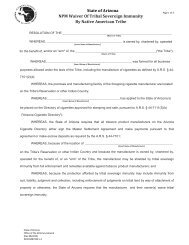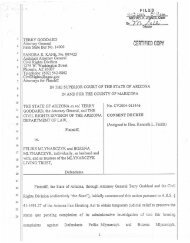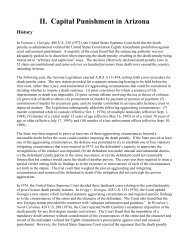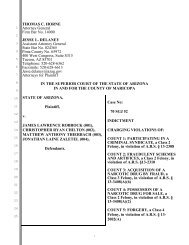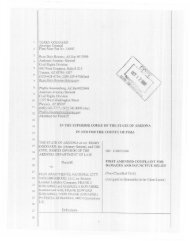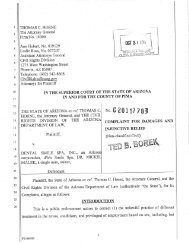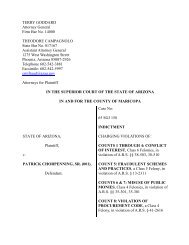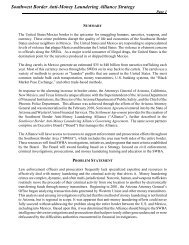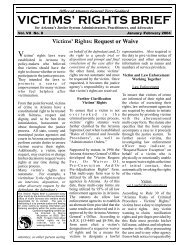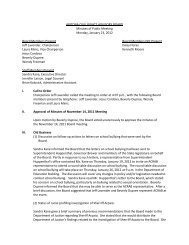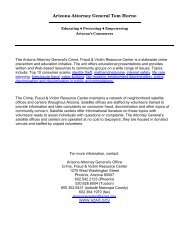Motion - Arizona Attorney General
Motion - Arizona Attorney General
Motion - Arizona Attorney General
Create successful ePaper yourself
Turn your PDF publications into a flip-book with our unique Google optimized e-Paper software.
UNITED STATES DISTRICT COURTFOR THE DISTRICT OF COLUMBIA________________________________________________STATE OF CALIFORNIA, by and through )ARNOLD SCHWARZENEGGER, )GOVERNOR OF THE STATE OF CALIFORNIA, )and the CALIFORNIA AIR RESOURCES BOARD, ) Case No. 1:07-CV-02024)Plaintiff, )) MOTION TOv. ) INTERVENE AS) PARTY PLAINTIFFSTHE UNITED STATES ENVIRONMENTAL )PROTECTION AGENCY, and )STEPHEN L. JOHNSON, Administrator, ))Defendants. )________________________________________________)The Commonwealth of Massachusetts and the States of New York, <strong>Arizona</strong>, Connecticut,Illinois, Maine, Maryland, New Jersey, New Mexico, Oregon, Rhode Island, Vermont,Washington, and the Commonwealth of Pennsylvania Department of Environmental Protection(“the Proposed Intervenors”) move to intervene as party-plaintiffs pursuant to Fed. R. Civ. Pro.24(a) and (b). A proposed complaint is annexed to this motion as Exhibit A.1. On October 24, 2007, the State of California (“California”), by and throughGovernor Arnold Schwarzenegger, and the California Air Resources Board (“CARB”), filed acomplaint in this Court seeking to compel the United States Environmental Protection Agency(“EPA”), and its Administrator, Stephen L. Johnson, to decide California’s petition for a waiverof federal preemption, as provided for in Section 209(b) of the Clean Air Act (“CAA”), 42U.S.C. § 7543(b), with respect to California’s Regulation to Control Greenhouse Gas Emissionsfrom Motor Vehicles (Cal. Code Regs. tit. 13, §§ 1900, 1961, 1961.1 (2007); CARB Exec. Order1
No. G-05-061, Cal. Reg. Notice Register 2005, No. 39-Z, at 1427-28 (2005)). This regulationrequires reductions in fleet-average, greenhouse-gas emissions for most new motor vehicles soldin California, beginning with the 2009 model-year.2. California, acting through CARB, requested the waiver of preemption from EPAon December 21, 2005 (EPA Docket EPA-HQ-OAR-2006-0173), pursuant to CAA § 209(b), butas California’s petition to this Court demonstrates, EPA has unreasonably delayed acting on thewaiver request.3. The Proposed Intervenors have strong interests in ensuring that EPA grantsCalifornia’s waiver petition without any further unnecessary delay, as each of them haspromulgated or is contemplating promulgating California’s motor vehicle greenhouse gasemissions standards, which cannot be enforced unless and until EPA grants California’s waiver.BACKGROUNDStatutory Background: the Clean Air Act4. The CAA authorizes the EPA to regulate tailpipe emissions from new motorvehicles. CAA § 202, 42 U.S.C. § 7521. Although the CAA generally prohibits states fromadopting their own emission standards for new motor vehicles, CAA § 209, 42 U.S.C. § 7543(a),CAA § 209(b) grants California the authority to set its own emission standards because of thestate’s long-standing, severe air pollution problems as well as its pioneering effortsin adopting“motor vehicle emission standards different from and in large measure more advanced than thecorresponding federal program; in short, to act as a kind of laboratory for innovation.” Motor andEquip. Mfrs. Ass'n, Inc. v. EPA, 627 F.2d 1095, 1110-1111 (D.C. Cir.1979). Under CAA §209(b), California must request and be granted a waiver of preemption from EPA before it may2
enforce its regulations.In 1977, Congress added CAA § 177, 42 U.S.C. § 7507, which authorizes other states toadopt emission standards for new motor vehicles that are identical to those California standardsfor which a waiver has been granted by EPA.California’s Adoption of its Greenhouse Gas Emission Regulationand Request for a Waiver5. Recognizing that motor vehicles are the second greatest source of greenhouse gasemissions, CARB in September 2004approved regulations that limit the amount of greenhousegases that light- and medium-duty passenger vehicles sold in California may emit. See, e.g.,2005 Cal. Regulatory Notice Reg. 1427 (Sept. 30, 2005) (noting 2004 amendments).6. On December 21, 2005, pursuant to § 209, California requested a waiver ofpreemption for its greenhouse gas regulations from EPA.Because Proposed Intervenors Have or Expect to Adopt California’s Greenhouse GasRegulation, the Proposed Intervenors Have a Substantial Interest in this Action7. Pursuant to their authority under CAA § 177, 42 U.S.C. § 7507, many of theProposed Intervenors have adopted or promulgated the greenhouse gas emissions regulation firstadopted by California. See Conn. Agencies Regs. § 22a-174-36b; 06-096 Code of Maine Regs.Ch. 127; 310 Code of Mass. Regs. 7.40; N.J. Admin. Code 7:27-29; Title 6 of the N.Y. Code ofRules and Regs., Part 218-8; Ore. Admin. Regs. 340-257-0100; 25 Pa. Code § 126.411; R. I.Low Emission Vehicle Program, Air Pollution Control Reg. No. 37.; Vt. Air Pollution ControlRegs. Subch. XI and App. F; Wash. Admin. Code Ch.173-423.8. Proposed Intervenors Maryland and New Mexico are in the process ofpromulgating the GHG regulation, see 34 Md. Reg. 1609; 20.2.88 NMAC.3
9. Pursuant to Executive Order 2006-13, plaintiff-intervenor <strong>Arizona</strong> is in theprocess of drafting rules adopting the California GHG regulation.10. Proposed Intervenor Illinois is considering adoption of the GHG regulation firstadopted by California.11. Indeed, some of the Proposed Intervenors are required as a matter of state law toadopt California’s emission standards. See, e.g., Conn. Gen. Stat. § 22a-174g; 06-096 Code ofMaine Regs. Ch. 127; Md. Code Ann. Envir. § 2-1102 (2007); Mass. G. L. Ch. 111, § 142K; N.J.Stat. Ann. § 26:2C-8.15 et seq.; Ore. Admin. Regs. 340-257-0100; Rev. Code Wash. 70.120A.12. However, before the motor vehicle greenhouse gas regulations of the ProposedIntervenors can be enforced, EPA must first decide – and grant – California’s waiver application.The Proposed Intervenors Also Have a Substantial Interest in This ActionBecause of the Effects of Global Warming on Their States13. The Proposed Intervenors have adopted or promulgated, or are contemplatingadopting or promulgating, the greenhouse gas emissions regulation first adopted by California,because, like California, they recognize that motor vehicles are one of the most significantsources of the greenhouse gases that cause global warming. Global warming, in turn, is alreadynegatively impacting the public health, economies and environments of the Proposed Intervenors.The effects of global warming are very serious, and in the absence of any abatement in globalwarming, these effects will only worsen. A few examples follow.14. Global warming accelerates sea level rise, which threatens coastal populations,vital infrastructure and property, and delicate ecosystems. Seehttp://yosemite.epa.gov/OAR/globalwarming.nsf/content/CoastalZones.html. Many of the4
Proposed Intervenors – Maine, Massachusetts, Connecticut, Rhode Island, New Jersey, NewYork, Maryland, Oregon, and Washington – have significant coastlines and densely populatedcoastal areas. States on the East Coast below Cape Cod are particularly vulnerable to problemssuch as loss of coastal wetlands, erosion of beaches, saltwater intrusion of drinking water, anddecreased longevity of low-lying infrastructure because this part of the East Coast is low andsandy. See, e.g., See EPA, “Climate Change and Connecticut,” (Sept. 1997) (“CT Impacts”) at3; Climate Change and Maryland” (Sept. 1998) (“MD Impacts”) at 3; “Climate Change andMassachusetts” (Sept. 1997) (“MA Impacts”) at 3; “Climate Change and New Jersey” (Sept.1997) (“NJ Impacts”) at 3; “Climate Change and New York” (Sept. 1997) (“NY Impacts”) at 3;“Climate Change and Rhode Island” (Sept. 1997) (“RI Impacts”) at 3.One of the causes of sea level rise is ice melt, which is occurring far faster than scientistshad previously thought. See Richard A. Kerr, “Is Battered Arctic Sea Ice Down For the Count?”Science, Oct. 5, 2007, at 33-34; Daniel Cressey, “Arctic Melt Opens Northwest Passage,” Nature449, 267 - 267 (19 Sep 2007); Andrew C. Revkin, “Arctic Melt Unnerves the Experts,” N.Y.Times, Oct. 2, 2007 (“The pace of change has far exceeded what had been estimated by almostall simulations used to envision how the Arctic will respond to rising concentrations ofgreenhouse gases linked to global warming.”).15. Of equal concern are two recent studies that strongly suggest a link betweenincreased global warming and hurricanes. See P.J. Webster, et. al, “Changes in Tropical CycloneNumber, Duration, and Intensity in a Warming Environment,” Science, Sept. 16, 2005, Vol. 309.no. 5742, at 1844-1846 (showing that in the last 35 years the number of category 4 and 5hurricanes has almost doubled); Kerry Emanuel, “Increasing Destructiveness of Tropical5
Cyclones over the past 30 Years,” Nature, July 31, 2005 (finding a similar increase in intensity instorms in the Atlantic and western North Pacific). Because these weather events would besuperimposed on a higher sea level, they would cause damage over a larger area.16. Heat waves have become more prolonged and intense with global warming. SeeCenter for Health and the Global Environment, Harvard Medical School, “Climate ChangeFutures: Health, Ecological and Economic Dimensions” (Nov. 2005) (“Climate ChangeFutures”) at 53. In the United States, heat waves are the most prominent cause of weather-relatedmortality, exceeding the mortality rates for all other weather events combined. See S. A.Changnon, et al., “Impacts and Responses to the 1995 Heat Wave: A Call to Action,” Bull. Am.Meteorol. Soc. 77:1497-1506 (1996). Many Mid-Atlantic and Midwestern states, with theirirregular, intense heat waves, are particularly susceptible to heat-related deaths and illnesses. SeeCT Impacts at 3; “Climate Change and Illinois,” (Sept. 1997) (“IL Impacts”) at 3; MA Impacts at3; MD Impacts at 2-3; NJ Impacts at 3; NY Impacts at 3; “Climate Change and Pennsylvania,”(Sept. 1997) (“PA Impacts”) at 3; RI Impacts at 3.17. Rising temperatures also lead to increased air pollution levels, with their attendantincreases in respiratory illness and death. Seehttp://yosemite.epa.gov/OAR/globalwarming.nsf/content/health.html. The presence of groundlevelozone in concentrations above the national ambient air quality standard has significantadverse health affects in these non-attainment areas, including increased hospitalizations andmortality risk for people with asthma and other respiratory diseases. SeeEPAWebsite/Impactshealth.html. Many proposed intervenors have large areas of the state thatare in non-attainment for national ambient air quality standards for ozone. See, e.g., MA Impacts6
at 3; NY Impacts at 3; PA Impacts at 3. In other cases, the entire state, or virtually the entirestate, is in non-attainment for ozone. See, e.g., CT Impacts at 3; MD Impacts at 3; NJ Impacts at3; RI Impacts at 3.18. Hotter, drier weather could increase the frequency and intensity of wildfires inWestern and Pacific Northwestern states. See EPA, “Climate Change and <strong>Arizona</strong>,” (Sept.1997) (“AZ Impacts”) at 4; “Climate Change and New Mexico” (Sept. 1997) (NM Impacts) at 4;EPA, “Oregon and Climate Change” (“OR Impacts”) at 4; “Washington and Climate Change”(“WA Impacts”) at 4.19. Other effects include disrupted water supplies. For example, warmertemperatures have already resulted in decreased mountain snowfall, which negatively impactsstates that depend on mountain snowpack for part of their water supply, such as states in thePacific Northwest and New England. See, e.g., OR Impacts at 3; WA Impacts at 4; EPA,“Climate Change and Maine” (Sept. 1998) (“ME Impacts”) at 4; MA Impacts at 4; EPA,“Climate Change and Vermont” (“VT Impacts”) at 4.20. Another effect is the alteration of forest character, including the loss of hardwoodtrees that give many Northeastern forests their brilliant fall colors and support tourism and themaple syrup industry. See CT Impacts at 4; MA Impacts at 4; ME Impacts at 4; VT Impacts at 4.21. The undertaking of projects to prepare for harmful global warming effects -- forexample, modifying infrastructure to withstand rising sea levels and increased severe weather --are long-term projects that cannot practicably be deferred until a crisis is at hand.22. For Proposed Intervenors, adopting California’s motor vehicle greenhouse gasregulations is part of a larger state strategy to abate greenhouse gas emissions. For example,7
several Northeastern states have agreed to stabilize and reduce carbon dioxide emissions frompower plants. See http://www.rggi.org (describing the Regional Greenhouse Gas Initiative).Similarly, other states, including Massachusetts, Oregon, and Washington, have adopted statutesand/or regulations regulating carbon dioxide from power plants. See 310 Code Mass. Regs. 7.29;ORS 469.503 and Or. Admin. Rules 345-024-0500 to 0720; Rev. Code of Wash. 70.94.892,80.70; Wash. Admin. Code Ch. 173-407. In addition, 22 states, including several ProposedIntervenors, and the District of Columbia, have established Renewable Portfolio Standards,which require states to increase the percentage of energy that they obtain from low-carbon energysources such as solar, tidal and wind power. Seehttp://www.pewclimate.org/what_s_being_done/in_the_states/rps.cfm.ARGUMENTA. The Proposed Intervenors Satisfy the Standard for Intervention As of RightUnder Fed. R. Civ. Proc. 24(a).Federal Rule of Civil Procedure 24(a)(2) provides that:Upon timely application, anyone shall be permitted to intervene in an action: . . . .when the applicant claims an interest relating to the property or transaction whichis the subject of the action and the applicant is so situated that the disposition ofthe action may as a practical matter impair or impede the applicant’s ability toprotect that interest, unless the applicant’s interest is adequately represented byexisting parties.Fed. R. Civ. Proc. 24(a)(2). Rule 24(a) is construed liberally in favor of granting intervention. InRe Vitamins Antitrust Class Actions, 215 F.3d 26, 29 (D.C. Cir. 2000); Southwest Ctr. forthBiological Diversity v. Berg, 268 F.3d 810, 818 (9 Cir. 2001); Fed. Savings & Loan Ins. Corp.thv. Falls Chase Special Taxing Dist., 983 F.2d 211, 216 (11 Cir. 1993). The ProposedIntervenors easily meet all of these criteria.8
1. The Proposed Intervenors’ Ability to Regulate Motor VehicleGreenhouse Gas Emissions is Contingent Upon A Decision From EPA onCalifornia’s Waiver PetitionThis Circuit has granted intervention as of right when the intervenor’s “ability to protectits claimed interest may by impaired or impeded by the District Court’s disposition of theaction.” Williams and Humbert, Ltd. v. W & H Trade Marks, Ltd., 840 F.2d 72, 77 (D.C. Cir.1988). See also International Mortgage & Invest. Corp. v. Von Clemm, 301 F.2d 857, 862 (2dCir. 1962) (intervention granted under previous version of rule where decision in the matterth“would seriously prejudice” claimed interest); Yniguez v. <strong>Arizona</strong>, 939 F.2d 727, 737 (9 Cir.1991) (“the question . . . is whether the district court’s decision will result in practicalimpairment” of the interests of the applicants for intervention) (emphasis in original). The courtsare especially sensitive to the needs of states to intervene in actions that implicate state laws andpolicy interests. See Cascade Natural Gas Corp. v. El Paso Natural Gas Co., 386 U.S. 129, 135(1967) (allowing California to intervene as of right in an antitrust enforcement action to assert“California interests in a competitive system”).The Proposed Intervenors’ interest in this action will be more than “impaired” or“impeded” by EPA’s decision; their interest depends directly on EPA’s decision. The only wayProposed Intervenors’ motor vehicle greenhouse gas emission regulations can be enforced is ifEPA decides and grants California’s petition for waiver of federal preemption pursuant to CAA §209(b). As long as EPA refuses to act, the Proposed Intervenors’ efforts to control motor vehiclederived greenhouse gas emissions within their borders are completely stymied. See, e.g., MotorndVehicle Manufacturers Assoc. v. Jorling,17 F.3d 521, 534 (2 Cir. 1994) (New York can adopt,but not enforce, California emissions standards pending a waiver from EPA). Since this case9
asks the Court to order EPA to act expeditiously on California’s waiver petition, the ProposedIntervenors’ interest is clear and compelling.The application of effective greenhouse gas emission regulations would, at a minimum,begin the process of reducing and reversing global warming. It is not necessary that the ProposedIntervenors show that the regulations would solve the problem. Massachusetts v. EPA, 127 S.Ct.1438, 1457, 1458-1459, 167 L.Ed.2d 248, 75 USLW 4149 (2007) (“Agencies, like legislatures,do not generally resolve massive problems in one fell regulatory swoop.”)2. California May Not Adequately Represent Proposed Intervnors’ InterestsAn applicant meets the inadequate representation requirement if he “shows thatrepresentation of his interest ‘may be’ inadequate; and the burden of making that showing shouldbe treated as minimal.” Trbovich v. United Mine Workers, 404 U.S. 528, 538 n.10 (1972)(emphases added). See also Fund for Animals v. Norton, 322 F.3d 728, 735 (D.C. Cir. 2003)(burden is not onerous). Moreover, “[a] governmental party that enters a lawsuit solely torepresent the interests of its citizens . . . differs from other parties, public or private, that asserttheir own interests, even when these interests coincide.” United States v. Hooker Chems. &Plastics Corp., 749 F.2d 968 at 992 n.21 (emphasis added). Any doubts in favor of interventionshould be resolved in favor of intervention. See Federal Sav. & Loan Ins. Corp. v. Falls ChasethSpecial Taxing Dist., 983 F.2d 211, 216 (11 Cir. 1993).Because California has a unique status under the Clean Air Act, Proposed Intervenors’authority to enforce their emissions regulations is derived from California. California, however,may prosecute or settle this action in a manner that does not square with the interests of theProposed Intervenors. This potential difference between the interests of the Proposed Intervenors10
and California is not theoretical. Some of the Proposed Intervenors have previously foundthemselves opposed to California in other motor vehicle emissions regulation cases. See, e.g.,stAssoc. of Int’l Auto. Mfrs. v. Comm’r, Mass. Dep’t of Env. Prot., 208 F.3d 1, 5, 7-8 (1 Cir.2000) (although California repealed its “Zero Emissions Vehicle” (ZEV) program and enteredinto Memoranda of Understanding (MOA) with auto manufacturers, Massachusetts could notadopt the MOA because they were not considered “standards” under CAA §§ 209, 177).3. Proposed Intervenors’ Intervention Is Timely.The timeliness of a party’s intervention is to be determined by looking at all thecircumstances of the case, “especially weighing the factors of time elapsed since inception of thesuit, the purpose for which intervention is sought, the need for intervention as a means ofpreserving the applicant’s rights, and the probability of prejudice to those already parties in thecase.” Smoke v. Norton, 252 F.3d 468, 471 (D.C. Cir. 2001) (citing United States v. AT&T, 206U.S.App. D.C. 317, 642 F.2d 1285, 1295 (D.C. Cir. 1980). Given that Proposed Intervnors aremoving promptly after California filed its complaint, there can be no question of prejudice todefendant.B. Proposed Intervnors Should Be Granted Permissive Intervention.Should the Court deny Proposed Intervenors’ motion to intervene as of right, it shouldgrant Proposed Intervenors’ permissive intervention. This Court has the discretion to allowintervention when the proposed intervenor makes a timely application demonstrating that its“claim or defense and the main action have a question of law or fact in common.” Fed. R. Civ.P. 24(b). In exercising such discretion, courts “shall consider whether the intervention willunduly delay or prejudice the rights of the original parties.” Id.; see also Citizens for an Orderly11
Energy Policy, 101 F.R.D. at 502 (possibility of undue delay or prejudice is the “principalconsideration”).As discussed above in the Statutory Background section and Section A1, theenforceability of the Proposed Intervnors’ motor vehicle greenhouse gas emissions regulationrises or falls with EPA’s decision on California’s waiver application. Moreover, given thatCalifornia has just filed its complaint, there can be no question of prejudice to defendant.12
CONCLUSIONFor the foregoing reasons, Proposed Intervenors respectfully requests that the Court grantthis motion to intervene.Dated: November 8, 2007New York, New YorkRespectfully submitted,FOR THE STATE OF NEW YORKANDREW M. CUOMOATTORNEY GENERALKatherine KennedyMichael Myers/s/ Yueh-ru ChuAssistant <strong>Attorney</strong>s <strong>General</strong>th120 Broadway, 26 floorNew York, NY 10271(212) 416-6588FOR THE COMMONWEALTH OFMASSACHUSETTSMARTHA COAKLEYATTORNEY GENERALFrederick D. AugensternJames R. MilkeyWilliam L. PardeeAssistant <strong>Attorney</strong>s <strong>General</strong>Environmental Protection Division1 Ashburton Place, 18th FloorBoston, MA 02108(617) 727-2200 x. 242713
FOR THE STATE OF ARIZONATERRY GODDARDATTORNEY GENERALJoseph MikitishTamara HuddlestonAssistant <strong>Attorney</strong>s <strong>General</strong>1275 W. WashingtonPhoenix, <strong>Arizona</strong> 85007(602) 542-8553FOR THE STATE OF CONNECTICUTRICHARD BLUMENTHALATTORNEY GENERALKimberly MassicotteJose A. Suarez55 Elm StreetP.O. Box 120Hartford, CT 06106Phone: (860) 808-5250FOR THE STATE OF ILLINOISLISA MADIGANATTORNEY GENERALGerald T. KarrSenior Assistant <strong>Attorney</strong> <strong>General</strong>Environmental Bureau69 West Washington Street, Suite 1800Chicago, Illinois 60602(312) 814-3369FOR THE STATE OF MAINEG. STEVEN ROWEATTORNEY GENERALGerald D. ReidAssistant <strong>Attorney</strong> <strong>General</strong>Chief, Natural Resources DivisionDepartment of the <strong>Attorney</strong> <strong>General</strong>6 State House StationAugusta, Maine 04333(207) 626-854514
FOR THE STATE OF MARYLANDDOUGLAS F. GANSLERATTORNEY GENERALKathy M. KinseyAssistant <strong>Attorney</strong> <strong>General</strong>Maryland Department of the Environment1800 Washington BoulevardBaltimore, Maryland 21230410-537-3954FOR THE STATE OF NEW JERSEYANNE MILGRAMATTORNEY GENERALLisa MorelliAssistant <strong>Attorney</strong> <strong>General</strong>Richard J. Hughes Justice Complex25 Market Street, P.O. Box 093Trenton, NJ 08625(609) 633-8713FOR THE STATE OF NEW MEXICOGARY K. KINGATTORNEY GENERALStephen R. FarrisJudith Ann MooreAssistant <strong>Attorney</strong>s <strong>General</strong>P.O. Drawer 1508Santa Fe, NM 87504-1508(505) 827-6939FOR THE STATE OF OREGONHARDY MYERSATTORNEY GENERALPhilip SchradleSpecial Counsel to the <strong>Attorney</strong> <strong>General</strong>Richard WhitmanAssistant <strong>Attorney</strong> <strong>General</strong>1162 Court St. N.E.Salem, Oregon 97301(503) 378-600215
FOR THE COMMONWEALTHOF PENNSYLVANIA, DEPARTMENTOF ENVIRONMENTAL PROTECTIONSUSAN SHINKMAN, CHIEF COUNSELRichard P. Mather, Sr.Deputy Chief CounselKristen M. CampfieldRobert A. ReileyAssistant CounselRachel Carson State Office Bldg., 9th Flr.P.O. Box 8464Harrisburg, Pennsylvania 17105(717) 787-7060FOR THE STATE OF RHODE ISLANDPATRICK C. LYNCHATTORNEY GENERALPatricia K. JedeleSpecial Assistant <strong>Attorney</strong> <strong>General</strong>Office of the <strong>Attorney</strong> <strong>General</strong>150 South Main StreetProvidence, Rhode Island401-274-4400, ext. 2400FOR THE STATE OF VERMONTWILLIAM H. SORRELLATTORNEY GENERALKevin O. LeskeAssistant <strong>Attorney</strong> <strong>General</strong>109 State StreetMontpelier, VT 050609FOR THE STATE OF WASHINGTONROB McKENNAATTORNEY GENERALLeslie SeffernAssistant <strong>Attorney</strong> <strong>General</strong>Office of the <strong>Attorney</strong> <strong>General</strong>P.O. Box 40117Olympia, Washington 98504(360) 586-677016



